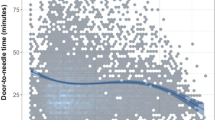Abstract
Timely treatment is essential in acute ischemic stroke as the chances of recovery diminish over time, so efforts are necessary to streamline in-hospital pathways and reduce delays. Here, we analyse the interventions to reduce door-to-needle time in stroke patients suitable for intravenous thrombolysis at the Emergency Department of San Carlo Borromeo Hospital, Milan, Italy. All stroke patients consecutively treated with intravenous thrombolysis at our centre from January 1, 2013 to December 31, 2015 were included in this analysis. The main interventions adopted were (1) continuous education of personnel, (2) reconsideration of blood tests and identify the ones really affecting treatment decision, (3) approval of a new high-urgency Stroke Code activated as soon as the triage nurse comes to know of a potential thrombolysis candidate. Median door-to-needle time progressively decreased from 103 min (iqr 78–120) in 2013, to 92 min (iqr 72–112) in 2014, and to 37 min (iqr 27–58) with the new Stroke Code (p < 0.001) in 2015. Simultaneously, median onset-to-treatment time decreased from 177 min (iqr 142–188) in 2013, to 155 min (iqr 141–198) in 2014, and to 114 min (iqr 86–160) with the new Stroke Code (p < 0.001 and p 0.005, respectively). We did not observe any significant difference in bleeding risks or deaths, whereas the likelihood of favourable outcome (mRS 0–2) increased. Streamlining in-hospital pathways with progressive interventions significantly decreases door-to-needle time and onset-to-treatment time and may contribute to improve stroke outcomes.


Similar content being viewed by others
References
Lees KR, Bluhmki E, von Kummer R et al (2010) Time to treatment with intravenous alteplase and outcome in stroke: an updated pooled analysis of ECASS, ATLANTIS, NINDS, and EPITHET trials. Lancet 375:1695–1703
Saver JL (2006) Time is brain—quantified. Stroke 37:263–266
Jauch EC, Saver JL, Adams HP et al (2013) Guidelines for the early management of patients with acute ischemic stroke: a guideline for healthcare professionals from the American Heart Association/American Stroke Association. Stroke 44:870–947
Evenson KR, Foraker RE, Morris DL et al (2009) A comprehensive review of prehospital and in-hospital delay times in acute stroke care. Int J Stroke 4(3):187–199
Meretoja A, Strbian D, Mustanoja S et al (2012) Reducing in-hospital delay to 20 minutes in stroke thrombolysis. Neurology 79(4):306–313
Meretoja A, Weir L, Ugalde M et al (2013) Helsinki model cut stroke thrombolysis delays to 25 minutes in Melbourne in only 4 months. Neurology 81(12):1071–1076
Rizos T, Herweh C, Jenetzky E et al (2009) Point-of-care international normalized ratio testing accelerates thrombolysis in patients with acute ischemic stroke using oral anticoagulants. Stroke 40(11):3547–3551
Emberson J, Lees KR, Lyden P et al (2014) Effect of treatment delay, age, and stroke severity on the effects of intravenous thrombolysis with alteplase for acute ischaemic stroke: a meta-analysis of individual patient data from randomised trials. Lancet 384:1929–1935
Flynn D, Ford GA, Rodgers H et al (2014) A time series evaluation of the FAST national stroke awareness campaign in England. PLoS One 9:e104289
Baldereschi M, Piccardi B, Di Carlo A et al (2012) Relevance of prehospital stroke code activation for acute treatment measures in stroke care: a review. Cerebrovasc Dis 34:182–190
Baldereschi M, Di Carlo A, Vaccaro C et al (2015) Stroke knowledge in Italy. Neurol Sci 36:415–421
Acknowledgements
The authors would like to thank all the ED nurses, carers, and internists and all the neurologists, radiologists and technicians who actively contributed to the improvement of the stroke chain of recovery at our hospital.
Author information
Authors and Affiliations
Contributions
Candelaresi P: conceived the initial idea of the study, searched the literature, analysed the data and wrote the first draft of the manuscript. Lattuada P: collected the data prospectively. Uggetti C, Daccò R, Fontana G and Frediani F: critically revised the manuscript. All authors approved the final version of the manuscript.
Corresponding author
Ethics declarations
Conflict of interest
The authors declare that they have no conflict of interest.
Rights and permissions
About this article
Cite this article
Candelaresi, P., Lattuada, P., Uggetti, C. et al. A high-urgency stroke code reduces in-hospital delays in acute ischemic stroke: a single-centre experience. Neurol Sci 38, 1671–1676 (2017). https://doi.org/10.1007/s10072-017-3046-y
Received:
Accepted:
Published:
Issue Date:
DOI: https://doi.org/10.1007/s10072-017-3046-y




